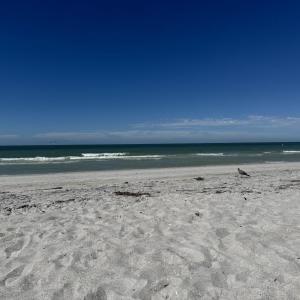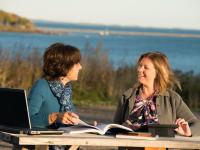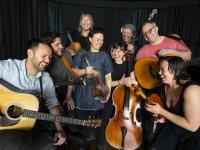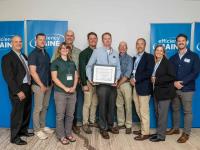Sharing Bird Connections on Warm White Beaches under Soft Blue Skies
 The authors enjoyed looking for birds on the warm, sandy beaches of Florida in October. Courtesy of Reese McAtee.
The authors enjoyed looking for birds on the warm, sandy beaches of Florida in October. Courtesy of Reese McAtee.
 The quintessential bird of the beach is the sanderling which nests in the Arctic but can be seen in both Maine and Florida. Photo by lwolfartist courtesy Wikimedia Commons.
The quintessential bird of the beach is the sanderling which nests in the Arctic but can be seen in both Maine and Florida. Photo by lwolfartist courtesy Wikimedia Commons.
 A laughing gull on the beach in Florida in October waiting sleepily to see if a human will spill some snacks or if a school of fish will make an appearance. Courtesy of Reese McAtee.
A laughing gull on the beach in Florida in October waiting sleepily to see if a human will spill some snacks or if a school of fish will make an appearance. Courtesy of Reese McAtee.
 The authors enjoyed looking for birds on the warm, sandy beaches of Florida in October. Courtesy of Reese McAtee.
The authors enjoyed looking for birds on the warm, sandy beaches of Florida in October. Courtesy of Reese McAtee.
 The quintessential bird of the beach is the sanderling which nests in the Arctic but can be seen in both Maine and Florida. Photo by lwolfartist courtesy Wikimedia Commons.
The quintessential bird of the beach is the sanderling which nests in the Arctic but can be seen in both Maine and Florida. Photo by lwolfartist courtesy Wikimedia Commons.
 A laughing gull on the beach in Florida in October waiting sleepily to see if a human will spill some snacks or if a school of fish will make an appearance. Courtesy of Reese McAtee.
A laughing gull on the beach in Florida in October waiting sleepily to see if a human will spill some snacks or if a school of fish will make an appearance. Courtesy of Reese McAtee.
Soft powder blue skies extend in all directions. The sea is shades of blue as well. Dark steel blue in the distance flecked with lines of white from barely curling wave tops sliced by the wind; aquamarine over sandbars nearer the shore. White sands extend north and south as far as we can see, miles and miles into the distance. The air is warm; the breezes gentle.
This is not a picture of the Maine coast in October as you can see. We are far away from our beloved home state for a short break to the Gulf Coast of Florida in the Tampa/St. Petersburg region.
Brown pelicans, looking large and unlike any Maine bird, glide by in abundance - sometimes singly, sometimes in small flocks flying in perfect formation like a squadron of elite fighter jets. Other times we see them sitting on the water near where there must be schools of fish, since above them is a tumult of plunging and wheeling sandwich terns and laughing gulls.
The laughing gulls no longer have their full black hoods as we see them for much of the year when they are nesting in the Gulf of Maine. Like gulls almost everywhere, they sit in little groups on the beach, eyeing the human beachgoers whenever snacks appear but also watching for the groupings of diving terns offshore. Somehow they seem to know when either the toddler has dropped the bag of chips on the beach or a school of fish are available for the taking a few hundred yards away. The little group of sleeping laughing gulls suddenly all take off and head straight to the lunch counter.
A favorite of ours has to be the sandwich terns. They seem almost gleaming white in the Florida beach brightness but when they pass overhead, that black bill with the little yellow tip is striking. We sure don’t see that species regularly in Maine!
But there are a number of birds that we’ve been seeing on those white sand beaches that are familiar migrants back home. The most quintessential beach bird everywhere has to be the sanderling. When the non-birder imagines the bird that runs back and forth with the shallow waves on a beach, that’s most likely a sanderling. When you see these little white and gray birds probing their black bills into the sand among humans on the beach, rock music jamming, brightly colored umbrellas and towels and bathing suits everywhere, it’s hard to fathom that they nest in the vast expanse of the Arctic, where they likely may not see a human for the summer.
We’ve been seeing other Arctic nesters here on the beach that use Maine as a migration stop-over location. They’ve all moulted into the subdued gray and whites that they use in winter to camouflage them on the featureless beaches and shores they inhabit. Black-bellied plovers, flashing their black armpits, are around. Red knots, not showing any of the red in their names but a flat battleship gray, are here. Ruddy turnstones, too, though they are slight exception to the rule of drabber winter garb showing off with some sharply contrasting rusty browns, blacks, and whites in the plumage.
The astonishment never stops, when you consider these same birds could connect us over such vast distances. A sanderling stopping by Maine in August could be more than 1,200 miles to the south in Florida in October. It could have been on the nesting grounds in the Arctic in Nunavut, Canada, in June or July, more than 1500 miles north of Maine.
What shared connections we have and what shared responsibilities we humans have across states and nations and regions.
Jeffrey V. Wells, Ph.D., is a Fellow of the Cornell Lab of Ornithology and Vice President of Boreal Conservation for National Audubon. Dr. Wells is one of the nation's leading bird experts and conservation biologists. He is a coauthor of the seminal “Birds of Maine” book and author of the “Birder’s Conservation Handbook.” His grandfather, the late John Chase, was a columnist for the Boothbay Register for many years. Allison Childs Wells, formerly of the Cornell Lab of Ornithology, is a senior director at the Natural Resources Council of Maine, a nonprofit membership organization working statewide to protect the nature of Maine. Both are widely published natural history writers and are the authors of the popular books, “Maine’s Favorite Birds” (Down East Books) and “Birds of Aruba, Bonaire, and Curaçao: A Site and Field Guide,” (Cornell University Press).






























